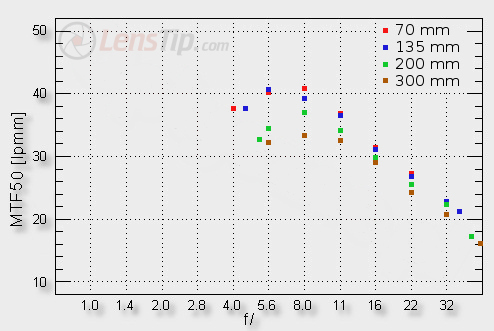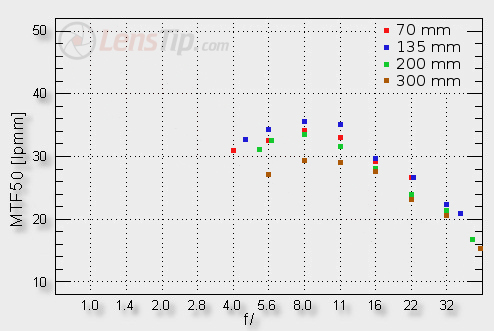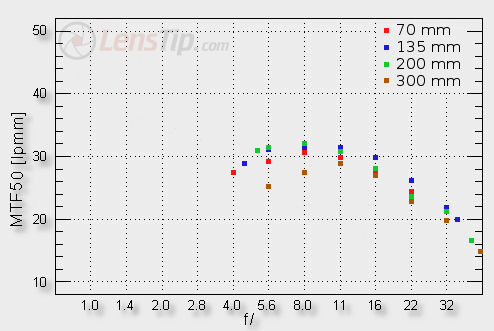Tamron SP 70-300 mm f/4-5.6 Di VC USD
4. Image resolution
At the beginning let’s check how the Tamron fares in the frame centre. The results it got for individual focal lengths are presented in the form of a graph below.

In the range from 70 to 135 mm the performance is beyond reproach. Even at the maximum relative aperture the results are very good and the lens gives us sharp images. There are no resolution records but, after all, nobody expects them in the case of an amateur zoom lens of the 70-300 mm class. The comparison to the Nikon 70-300 mm VR is a bit unfavourable for the Tamron, though. After taking into consideration the differences between the D200 and the D3x the results, presented by both lenses, are just 1-2 lpmm apart – such a difference is practically impossible to notice in real life photos. The advantage of the Tamron over the stabilized Sigma is easy to notice for a change (amounting to 4-5 lpmm).
Please Support UsIf you enjoy our reviews and articles, and you want us to continue our work please, support our website by donating through PayPal. The funds are going to be used for paying our editorial team, renting servers, and equipping our testing studio; only that way we will be able to continue providing you interesting content for free. |
- - - - - - - - - - - - - - - - - - - - - - - - - - - - - - - - - - - - - - - - - - - - - - - -
The 200 mm focal length is significantly weaker than the performance in the 70-135 mm range. Still the Tamron fares here better than the Sigma but it definitely loses when compared to the Nikkor. A reason to complain? Hardly. At the maximum relative aperture the results reach over 32 lpmm so the image is fully useful and on slight stopping down – even good. The 300 mm focal length is once again a bit worse but also fully useful even wide open. Such a trick was unattainable for the Sigma and the Canon 70-300 mm IS. Still the performance of the Nikkor is slightly better, perhaps apart from the maximum aperture, where both lenses are on a par which each other.
Let’s check how the lens fares on the edge of the DX sensor. The appropriate graph is presented below.

Certainly the lens presents a very even performance for the 70-300 mm class at all focal lengths and it should be praised here. In the 70-200 mm range the results are very similar and only the maximum aperture lags behind a bit. What’s important, apart from 300 mm, the maximum aperture is fully useful and even at these 300 mm we are very close the decency level. At shorter focal lengths the Tamron seems to be slightly better even than the Nikkor and at 300 mm both lenses perform neck and neck.
Let’s check what the Tamron 70-300 mm VC presents on the edge of full frame. Its achievements can be assessed by looking at the graph below.

Now you can understand clearly the vision of the Tamron optics constructors had. Most probably they were motivated by the idea of a balanced performance throughout the frame. The edges are better at the expense of the frame centre, where the results are slightly below par. That’s why the lens fares well on the edge of the DX sensor and decently on the edge of full frame - a task rather difficult to carry out in this class. The Sigma 70-300 mm OS learned that lesson in a painful way - only at 135 mm on the edge of full frame it was able to slightly exceed the level of 30 lpmm.
To sum up when it comes to the resolution the Tamron elbows his way among its rivals very firmly. It wins the duel with the Sigma and it seems to be slightly better than the Canon 70-300 mm IS. When it comes to competing with the Nikkor 70-300 mm VR we get a draw. The Nikkor is better in the frame centre, the Tamron – on edges.
 |






